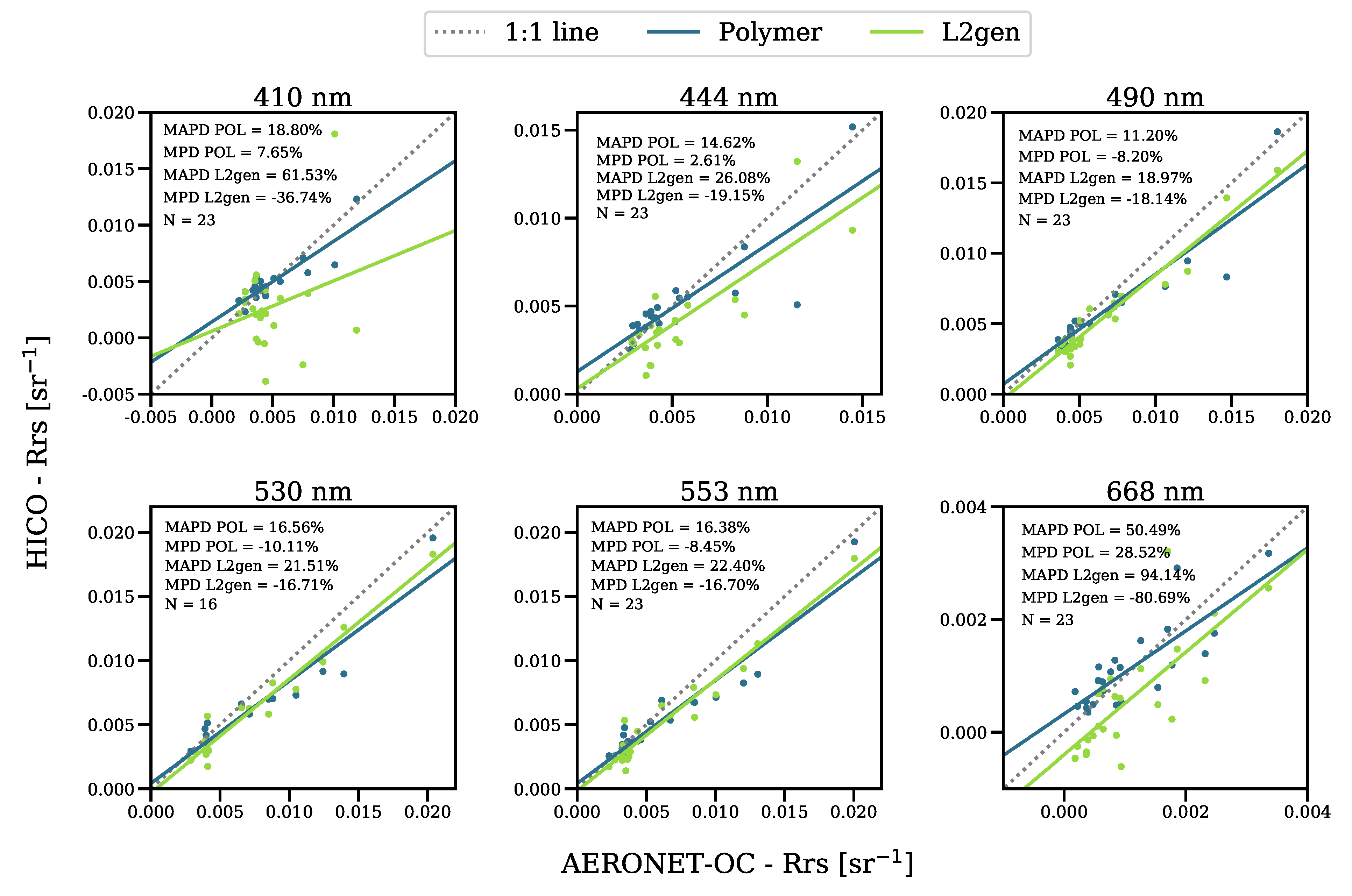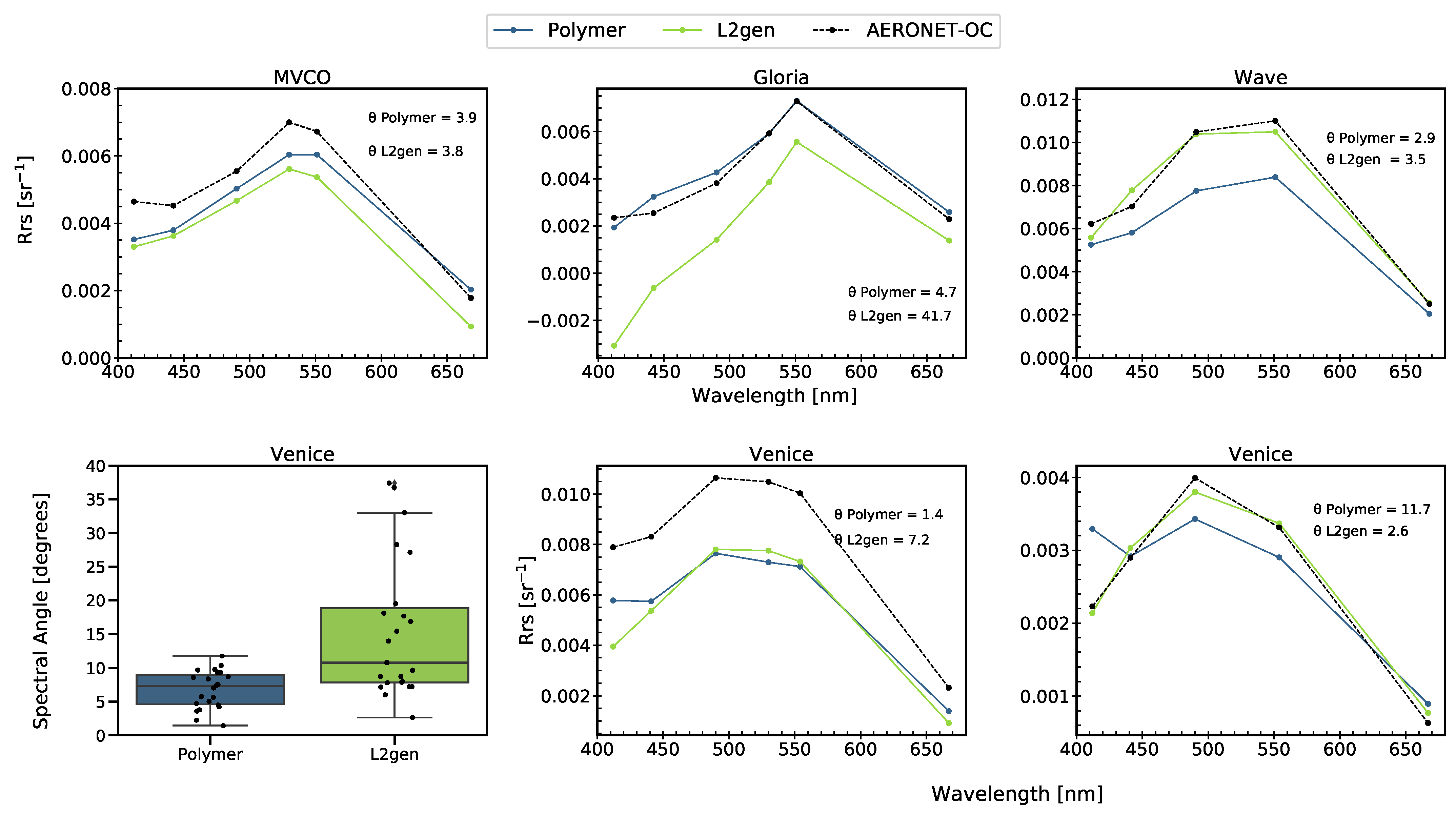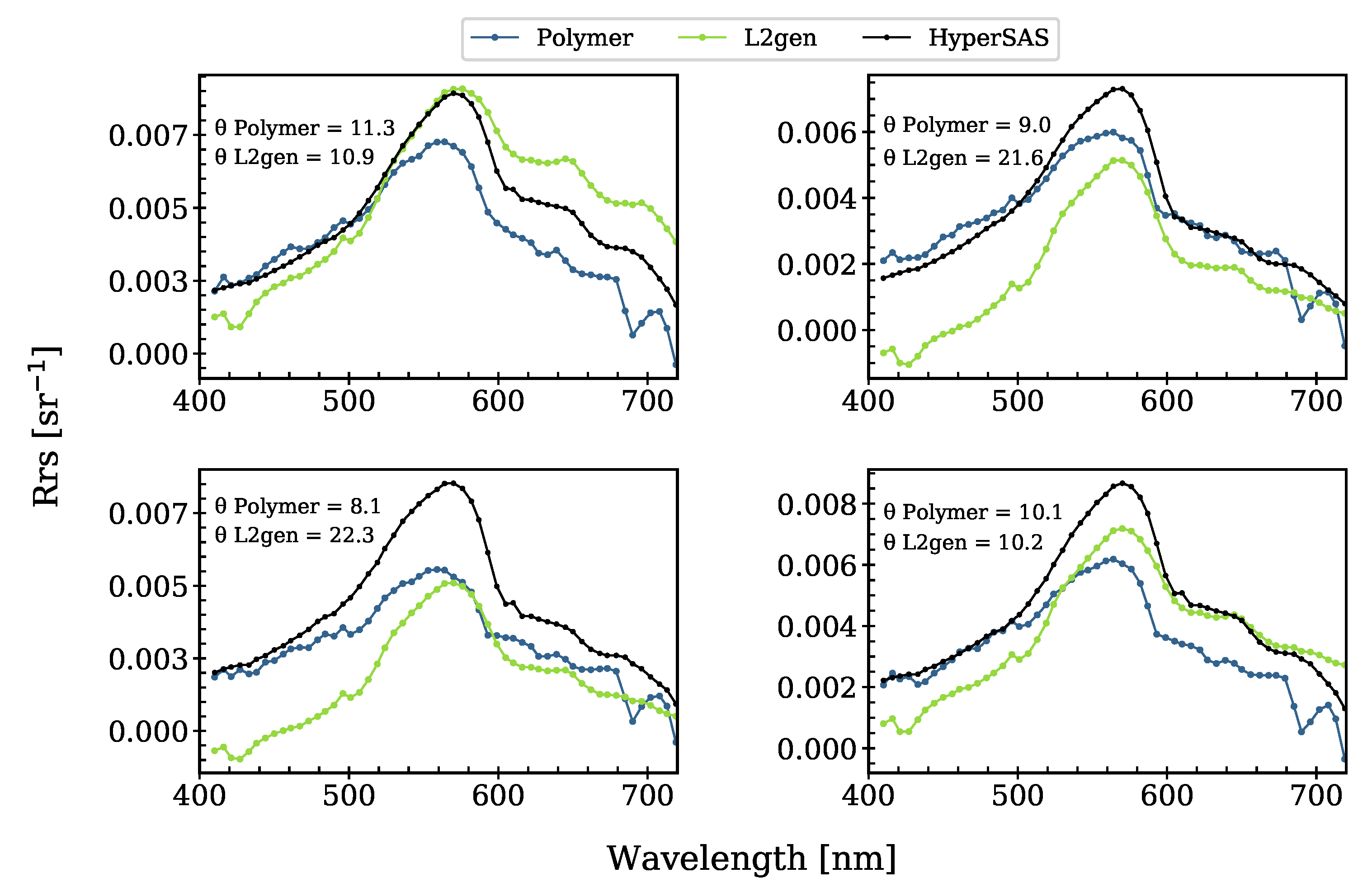Assessment of Polymer Atmospheric Correction Algorithm for Hyperspectral Remote Sensing Imagery over Coastal Waters
Abstract
1. Introduction
2. Materials and Methods
2.1. Atmospheric Correction Algorithms
2.2. In Situ Radiometric Data
2.3. Satellite Data and Validation
3. Results and Discussion
3.1. Match-Up Analysis
Quality Flags
3.2. Spectral Similarity Analysis
3.3. EnMAP-Box
4. Conclusions
Author Contributions
Funding
Institutional Review Board Statement
Informed Consent Statement
Data Availability Statement
Acknowledgments
Conflicts of Interest
Abbreviations
| AC | atmospheric correction |
| AERONET | AErosol RObotic NETwork |
| AROSICS | An Automated and Robust Open-Source Image Co-Registration Software for Multi-Sensor Satellite Data |
| BRDF | Bidirectional Reflectance Distribution Function |
| CHIME | Copernicus Hyperspectral Imaging Mission for the Environment |
| CHRIS | Compact High Resolution Imaging Spectrometer |
| DESIS | DLR Earth Sensing Imaging Spectrometer |
| DLR | Deutsche Zentrum für Luft- und Raumfahrt (German Aerospace Center) |
| EnMAP | Environmental Mapping and Analysis Program |
| EnPT | EnMAP processing tool |
| ESA | European Space Agency |
| GOME | Global Ozone Monitoring Experiment |
| HISUI | Hyperspectral Imager Suite |
| HICO | Hyperspectral Imager for the Coastal Ocean |
| ISS | International Space Station |
| MAPD | mean absolute percentage difference |
| MPD | mean percentage difference |
| NASA | National Aeronautics and Space Administration |
| NIR | near-infrared |
| OC | Ocean Colour |
| OCI | Ocean Colour Instrument |
| OLCI | Ocean and Land Colour Instrument |
| OMI | Ozone Monitoring Instrument |
| PACE | Plankton, Aerosol, Cloud, ocean Ecosystem |
| PRISMA | PRecursore IperSpettrale della Missione Applicativa |
| PRISMA SG | PRISMA Second Generation |
| SA | spectral angle |
| SBG | Surface Biology and Geology |
| SCIAMACHY | Scanning Imaging Absorption Spectrometer for Atmospheric Chartography |
| Sentinel-5P | Sentinel-5 Precursor |
| SICOR | Sensor-Independent Atmospheric Correction of optical Earth observation data from multi- and hyper-spectral instruments |
| SHALOM | Spaceborne Hyperspectral Applicative Land and Ocean Mission |
| SNR | signal-to-noise ratio |
| SWIR | short-wavelength infrared |
| VIS | visible |
| VNIR | visible and near-infrared |
| TROPOMI | TROPOspheric Monitoring Instrument |
References
- Frouin, R.J.; Franz, B.A.; Ibrahim, A.; Knobelspiesse, K.; Ahmad, Z.; Cairns, B.; Chowdhary, J.; Dierssen, H.M.; Tan, J.; Dubovik, O.; et al. Atmospheric Correction of Satellite Ocean-Color Imagery During the PACE Era. Front. Earth Sci. 2019, 7, 145. [Google Scholar] [CrossRef]
- Steinmetz, F.; Deschamps, P.Y.; Ramon, D. Atmospheric correction in presence of sun glint: Application to MERIS. Opt. Express 2011, 19, 9783–9800. [Google Scholar] [CrossRef]
- Steinmetz, F.; Ramon, D. Sentinel-2 MSI and Sentinel-3 OLCI consistent ocean colour products using POLYMER. In Proceedings of the Remote Sensing of the Open and Coastal Ocean and Inland Waters, International Society for Optics and Photonics, Honolulu, HI, USA, 24–25 September 2018; Volume 10778, p. 107780E. [Google Scholar]
- Gordon, H.R.; Wang, M. Retrieval of water-leaving radiance and aerosol optical thickness over the oceans with SeaWiFS: A preliminary algorithm. Appl. Opt. 1994, 33, 443–452. [Google Scholar] [CrossRef]
- Ahmad, Z.; Franz, B.A.; McClain, C.R.; Kwiatkowska, E.J.; Werdell, J.; Shettle, E.P.; Holben, B.N. New aerosol models for the retrieval of aerosol optical thickness and normalized water-leaving radiances from the SeaWiFS and MODIS sensors over coastal regions and open oceans. Appl. Opt. 2010, 49, 5545–5560. [Google Scholar] [CrossRef]
- Ibrahim, A.; Franz, B.; Ahmad, Z.; Healy, R.; Knobelspiesse, K.; Gao, B.C.; Proctor, C.; Zhai, P.W. Atmospheric correction for hyperspectral ocean color retrieval with application to the Hyperspectral Imager for the Coastal Ocean (HICO). Remote Sens. Environ. 2018, 204, 60–75. [Google Scholar] [CrossRef]
- Müller, D.; Krasemann, H.; Brewin, R.J.; Brockmann, C.; Deschamps, P.Y.; Doerffer, R.; Fomferra, N.; Franz, B.A.; Grant, M.G.; Groom, S.B.; et al. The Ocean Colour Climate Change Initiative: II. Spatial and temporal homogeneity of satellite data retrieval due to systematic effects in atmospheric correction processors. Remote Sens. Environ. 2015, 162, 257–270. [Google Scholar] [CrossRef]
- Qin, P.; Simis, S.G.; Tilstone, G.H. Radiometric validation of atmospheric correction for MERIS in the Baltic Sea based on continuous observations from ships and AERONET-OC. Remote Sens. Environ. 2017, 200, 263–280. [Google Scholar] [CrossRef]
- Mograne, M.A.; Jamet, C.; Loisel, H.; Vantrepotte, V.; Mériaux, X.; Cauvin, A. Evaluation of Five Atmospheric Correction Algorithms over French Optically-Complex Waters for the Sentinel-3A OLCI Ocean Color Sensor. Remote Sens. 2019, 11, 668. [Google Scholar] [CrossRef]
- Pereira-Sandoval, M.; Ruescas, A.; Urrego, P.; Ruiz-Verdú, A.; Delegido, J.; Tenjo, C.; Soria-Perpinyà, X.; Vicente, E.; Soria, J.; Moreno, J. Evaluation of Atmospheric Correction Algorithms over Spanish Inland Waters for Sentinel-2 Multi Spectral Imagery Data. Remote Sens. 2019, 11, 1469. [Google Scholar] [CrossRef]
- Warren, M.; Simis, S.; Martinez-Vicente, V.; Poser, K.; Bresciani, M.; Alikas, K.; Spyrakos, E.; Giardino, C.; Ansper, A. Assessment of atmospheric correction algorithms for the Sentinel-2A MultiSpectral Imager over coastal and inland waters. Remote Sens. Environ. 2019, 225, 267–289. [Google Scholar] [CrossRef]
- Giannini, F.; Hunt, B.P.; Jacoby, D.; Costa, M. Performance of OLCI Sentinel-3A satellite in the Northeast Pacific coastal waters. Remote Sens. Environ. 2021, 256, 112317. [Google Scholar] [CrossRef]
- Guanter, L.; Kaufmann, H.; Segl, K.; Foerster, S.; Rogass, C.; Chabrillat, S.; Kuester, T.; Hollstein, A.; Rossner, G.; Chlebek, C.; et al. The EnMAP spaceborne imaging spectroscopy mission for earth observation. Remote Sens. 2015, 7, 8830–8857. [Google Scholar] [CrossRef]
- Park, Y.J.; Ruddick, K. Model of remote-sensing reflectance including bidirectional effects for case 1 and case 2 waters. Appl. Opt. 2005, 44, 1236–1249. [Google Scholar] [CrossRef]
- Bailey, S.W.; Franz, B.A.; Werdell, P.J. Estimation of near-infrared water-leaving reflectance for satellite ocean color data processing. Opt. Express 2010, 18, 7521–7527. [Google Scholar] [CrossRef]
- Morel, A.; Antoine, D.; Gentili, B. Bidirectional reflectance of oceanic waters: Accounting for Raman emission and varying particle scattering phase function. Appl. Opt. 2002, 41, 6289–6306. [Google Scholar] [CrossRef] [PubMed]
- Thuillier, G.; Hersé, M.; Foujols, T.; Peetermans, W.; Gillotay, D.; Simon, P.; Mandel, H. The solar spectral irradiance from 200 to 2400 nm as measured by the SOLSPEC spectrometer from the ATLAS and EURECA missions. Solar Phys. 2003, 214, 1–22. [Google Scholar] [CrossRef]
- Keith, D.J.; Schaeffer, B.A.; Lunetta, R.S.; Gould, R.W., Jr.; Rocha, K.; Cobb, D.J. Remote sensing of selected water-quality indicators with the hyperspectral imager for the coastal ocean (HICO) sensor. Int. J. Remote Sens. 2014, 35, 2927–2962. [Google Scholar] [CrossRef]
- Han, L.; Jordan, K.J. Estimating and mapping chlorophyll concentration in Pensacola Bay, Florida using Landsat ETM+ data. Int. J. Remote Sens. 2005, 26, 5245–5254. [Google Scholar] [CrossRef]
- Mishra, D.; Schaeffer, B.; Keith, D. Performance evaluation of normalized difference chlorophyll index in northern Gulf of Mexico estuaries using the Hyperspectral Imager for the Coastal Ocean. GIScience Remote Sens. 2014, 51. [Google Scholar] [CrossRef]
- Burggraaff, O. Biases from incorrect reflectance convolution. Opt. Express 2020, 28, 13801–13816. [Google Scholar] [CrossRef]
- Corson, M.R.; Davis, C.O. A new view of coastal oceans from the space station. EOS Trans. Am. Geophys. Union 2011, 92, 161–162. [Google Scholar] [CrossRef]
- Lucke, R.L.; Corson, M.; McGlothlin, N.R.; Butcher, S.D.; Wood, D.L.; Korwan, D.R.; Li, R.R.; Snyder, W.A.; Davis, C.O.; Chen, D.T. Hyperspectral Imager for the Coastal Ocean: Instrument description and first images. Appl. Opt. 2011, 50, 1501–1516. [Google Scholar] [CrossRef]
- Hyperspectral Imager for the Coastal Ocean (HICO™) L1 and L2 Data; NASA Goddard Space Flight Center, Ocean Ecology Laboratory, Ocean Biology Processing Group: Greenbelt, MD, USA, 2019. [CrossRef]
- Zibordi, G.; Ruddick, K.; Ansko, I.; Moore, G.; Kratzer, S.; Icely, J.; Reinart, A. In situ determination of the remote sensing reflectance: An inter-comparison. Ocean Sci. 2012, 8, 567–586. [Google Scholar] [CrossRef]
- Seegers, B.N.; Stumpf, R.P.; Schaeffer, B.A.; Loftin, K.A.; Werdell, P.J. Performance metrics for the assessment of satellite data products: An ocean color case study. Opt. Express 2018, 26, 7404–7422. [Google Scholar] [CrossRef]
- Kruse, F.; Lefkoff, A.; Boardman, J.; Heidebrecht, K.; Shapiro, A.; Barloon, P.; Goetz, A. The spectral image processing system (SIPS)—Interactive visualization and analysis of imaging spectrometer data. Remote Sens. Environ. 1993, 44, 145–163. [Google Scholar] [CrossRef]
- Zibordi, G.; Mélin, F.; Berthon, J.F.; Holben, B.; Slutsker, I.; Giles, D.; D’Alimonte, D.; Vandemark, D.; Feng, H.; Schuster, G.; et al. AERONET-OC: A Network for the Validation of Ocean Color Primary Products. J. Atmos. Ocean. Technol. 2009, 26, 1634–1651. [Google Scholar] [CrossRef]
- Alikas, K.; Ansko, I.; Vabson, V.; Ansper, A.; Kangro, K.; Uudeberg, K.; Ligi, M. Consistency of Radiometric Satellite Data over Lakes and Coastal Waters with Local Field Measurements. Remote Sens. 2020, 12, 616. [Google Scholar] [CrossRef]
- Gitelson, A.A.; Gao, B.C.; Li, R.R.; Berdnikov, S.; Saprygin, V. Estimation of chlorophyll-a concentration in productive turbid waters using a Hyperspectral Imager for the Coastal Ocean—The Azov Sea case study. Environ. Res. Lett. 2011, 6, 024023. [Google Scholar] [CrossRef]
- Braga, F.; Giardino, C.; Bassani, C.; Matta, E.; Candiani, G.; Strömbeck, N.; Adamo, M.; Bresciani, M. Assessing water quality in the northern Adriatic Sea from HICO™ data. Remote Sens. Lett. 2013, 4, 1028–1037. [Google Scholar] [CrossRef]
- Garcia, R.A.; Fearns, P.R.; McKinna, L.I. Detecting trend and seasonal changes in bathymetry derived from HICO imagery: A case study of Shark Bay, Western Australia. Remote Sens. Environ. 2014, 147, 186–205. [Google Scholar] [CrossRef]
- Ryan, J.P.; Davis, C.O.; Tufillaro, N.B.; Kudela, R.M.; Gao, B.C. Application of the Hyperspectral Imager for the Coastal Ocean to Phytoplankton Ecology Studies in Monterey Bay, CA, USA. Remote Sens. 2014, 6, 1007–1025. [Google Scholar] [CrossRef]
- Mélin, F.; Zibordi, G.; Berthon, J.F. Assessment of satellite ocean color products at a coastal site. Remote Sens. Environ. 2007, 110, 192–215. [Google Scholar] [CrossRef]
- Pahlevan, N.; Smith, B.; Binding, C.; Gurlin, D.; Li, L.; Bresciani, M.; Giardino, C. Hyperspectral retrievals of phytoplankton absorption and chlorophyll-a in inland and nearshore coastal waters. Remote Sens. Environ. 2021, 253, 112200. [Google Scholar] [CrossRef]
- Gao, B.C.; Li, R.R.; Lucke, R.L.; Davis, C.O.; Bevilacqua, R.M.; Korwan, D.R.; Montes, M.J.; Bowles, J.H.; Corson, M.R. Vicarious calibrations of HICO data acquired from the International Space Station. Appl. Opt. 2012, 51, 2559–2567. [Google Scholar] [CrossRef] [PubMed]
- Steinmetz, F.; Ramon, D.; Deschamps, P. ATBD V1—Polymer Atmospheric Correction Algorithm; Rapport Technique; Plymouth Marine Laboratory: Plymouth, UK, 2016. [Google Scholar]
- Scheffler, D.; Bohn, N.; Guillaso, S.; Segl, K. EnPT—EnMAP Processing Tool Python Package. 2021. Available online: https://pypi.org/project/enpt/ (accessed on 15 June 2021).
- Van der Linden, S.; Rabe, A.; Held, M.; Jakimow, B.; Leitão, P.; Okujeni, A.; Schwieder, M.; Suess, S.; Hostert, P. The EnMAP-Box—A Toolbox and Application Programming Interface for EnMAP Data Processing. Remote Sens. 2015, 7, 11249–11266. [Google Scholar] [CrossRef]
- QGIS Development Team. QGIS Geographic Information System. 2021. Available online: https://www.qgis.org/en/site/ (accessed on 15 June 2021).
- Scheffler, D.; Hollstein, A.; Diedrich, H.; Segl, K.; Hostert, P. AROSICS: An Automated and Robust Open-Source Image Co-Registration Software for Multi-Sensor Satellite Data. Remote Sens. 2017, 9, 676. [Google Scholar] [CrossRef]
- Scheffler, D. AROSICS Python Package: An Automated and Robust Open-Source Image Co-Registration Software for Multi-Sensor Satellite Data. 2021. Available online: https://pypi.org/project/arosics/ (accessed on 15 June 2021).
- Bohn, N.; Guanter, L.; Kuester, T.; Preusker, R.; Segl, K. Coupled retrieval of the three phases of water from spaceborne imaging spectroscopy measurements. Remote Sens. Environ. 2020, 242, 111708. [Google Scholar] [CrossRef]
- Silva, B. GitHub Repository of the Phytooptics Group at Alfred Wegener Institute; GitHub Repository; GitHub: London, UK, 2021. [Google Scholar]
- IOCCG. Remote Sensing of Ocean Colour in Coastal, and Other Optically-Complex, Waters; Reports of the International Ocean-Colour Coordinating Group, No. 3; International Ocean Colour Coordinating Group: Dartmouth, NS, Canada, 2000; p. 140. [Google Scholar]
- Segl, K. EnMAP Test Data Products. 2021. Available online: https://www.enmap.org/data_tools/testdata/ (accessed on 15 June 2021).
- Vanhellemont, Q.; Ruddick, K. Advantages of high quality SWIR bands for ocean colour processing: Examples from Landsat-8. Remote Sens. Environ. 2015, 161, 89–106. [Google Scholar] [CrossRef]
- Gossn, J.I.; Ruddick, K.G.; Dogliotti, A.I. Atmospheric Correction of OLCI Imagery over Extremely Turbid Waters Based on the Red, NIR and 1016 nm Bands and a New Baseline Residual Technique. Remote Sens. 2019, 11, 220. [Google Scholar] [CrossRef]









| Station Name | Location | Years | Spectral Bands (nm) |
|---|---|---|---|
| COVE_SEAPRISM | N, W | 2013, 2014 | 413, 441, 489, 530, 551, 668 |
| MVCO | N, W | 2010, 2013, 2014 | 412, 442, 490, 530, 551, 668 |
| LISCO | N, W | 2010, 2011, 2012, 2014 | 413, 442, 491, 551, 668 |
| WaveCIS_site_CSI_6 | N, W | 2010, 2011, 2012, 2013, 2014 | 411, 442, 491, 551, 668 |
| Gloria | N, E | 2012, 2014 | 411, 412, 442, 490, 491, 530, 551, 667, 668 |
| Venice | N, E | 2010, 2011, 2012, 2013, 2014 | 412, 441, 442, 488, 490, 491, 530, 551, 554, 555, 667, 668 |
Publisher’s Note: MDPI stays neutral with regard to jurisdictional claims in published maps and institutional affiliations. |
© 2021 by the authors. Licensee MDPI, Basel, Switzerland. This article is an open access article distributed under the terms and conditions of the Creative Commons Attribution (CC BY) license (https://creativecommons.org/licenses/by/4.0/).
Share and Cite
Soppa, M.A.; Silva, B.; Steinmetz, F.; Keith, D.; Scheffler, D.; Bohn, N.; Bracher, A. Assessment of Polymer Atmospheric Correction Algorithm for Hyperspectral Remote Sensing Imagery over Coastal Waters. Sensors 2021, 21, 4125. https://doi.org/10.3390/s21124125
Soppa MA, Silva B, Steinmetz F, Keith D, Scheffler D, Bohn N, Bracher A. Assessment of Polymer Atmospheric Correction Algorithm for Hyperspectral Remote Sensing Imagery over Coastal Waters. Sensors. 2021; 21(12):4125. https://doi.org/10.3390/s21124125
Chicago/Turabian StyleSoppa, Mariana A., Brenner Silva, François Steinmetz, Darryl Keith, Daniel Scheffler, Niklas Bohn, and Astrid Bracher. 2021. "Assessment of Polymer Atmospheric Correction Algorithm for Hyperspectral Remote Sensing Imagery over Coastal Waters" Sensors 21, no. 12: 4125. https://doi.org/10.3390/s21124125
APA StyleSoppa, M. A., Silva, B., Steinmetz, F., Keith, D., Scheffler, D., Bohn, N., & Bracher, A. (2021). Assessment of Polymer Atmospheric Correction Algorithm for Hyperspectral Remote Sensing Imagery over Coastal Waters. Sensors, 21(12), 4125. https://doi.org/10.3390/s21124125






